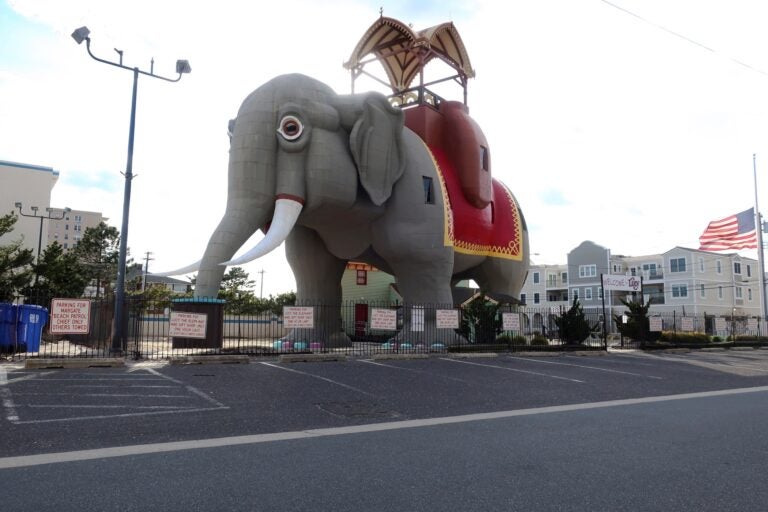Tall tale: Lucy the Elephant
At 139, Lucy the Elephant is still a hit. Here's the story of how the six-story wooden pachyderm came to be and avoided demolition to become a Jersey Shore icon.
Listen 12:36
National Historic Landmark Lucy the Elephant is closed to visitors and the parking lot is empty in Margate, New Jersey, during the coronavirus pandemic while a flag flies at half staff on April 10, 2020. (AP Photo/Ted Shaffrey)
At 139 years old, Lucy the Elephant has seen many things from the shores of Margate — from presidential visits to the threat of the wrecking ball and Hurricane Sandy. In March, the six-story wooden pachyderm was listed on Airbnb, only to close because of the coronavirus pandemic. She’s stood the test of time — and we’re sure she’ll get through this, too.
So on this Memorial Day, The Why takes you down the shore for one of our favorite episodes from last summer. WHYY’s Joe Hernandez explains how Lucy became a beloved Jersey Shore icon and why she’s still a hit.

Hear the whole story on The Why
Interview highlights
On Lucy’s origin story in the 1880s
She was built in what was then called South Atlantic City by this guy, James V. Lafferty. He was a real estate guy living in Philadelphia, but operating on the shore at the time. Margate, South Atlantic City was sort of marshy … not a lot of structures, not a lot going before it was developed … And somewhere along the way, James Lafferty said, “I know how to sell real estate better. I’ll build a giant elephant” … And so he built this thing and he filed for a patent for it. And I just want to read you from it, because I think it’s so fun: “Be it known that I, James V Lafferty, a citizen of the United States, residing in the city and county of Philadelphia, state of Pennsylvania have invented a new and useful improvement in buildings. My invention consists of a building in the form of an animal, the body of which is flawed and divided into rooms, closets, etc. and the legs contain the stairs which lead to the body.”
On her different incarnations over the decades
Lots of famous people or people who would become famous people … went and saw her — President Woodrow Wilson, Henry Ford. But, you know, she’s made of wood and tin and she’s getting beaten by the elements out there. So over time, she’s sort of fallen into disrepair. She became a bar, a hotel, a restaurant, a rooming house. She was divided up into apartments at some point and people lived in there. There was also a camp on the grounds … It’s like a big cavernous room like you might expect in a church building. In fact, even today, they hold weddings there sometimes. You know, you’re six stories up. You’re in Margate. So there aren’t a ton of tall buildings around you. So on a clear day, you have a really nice panoramic view — Atlantic City to your north, Cape May to your south, the ocean. It’s great.
On why Lucy the Elephant is still so beloved
I think part of it is just that ineffable weirdness of a giant elephant on the Jersey Shore, and like, how unusual it is. You know, I’m sort of joking, but also serious when I say that her story is one of kind of resiliency and resistance. I mean, ever since she was built, there have been efforts to develop around her … because it’s prime real estate. It’s really a nice, good piece of land that I think is desirable. And somehow she has managed to keep that away and resist that for all of these years. In some ways, that story is still continuing today.
WHYY is your source for fact-based, in-depth journalism and information. As a nonprofit organization, we rely on financial support from readers like you. Please give today.





